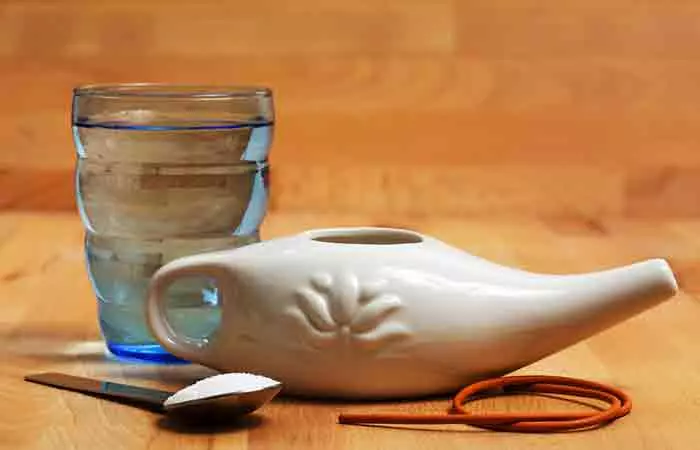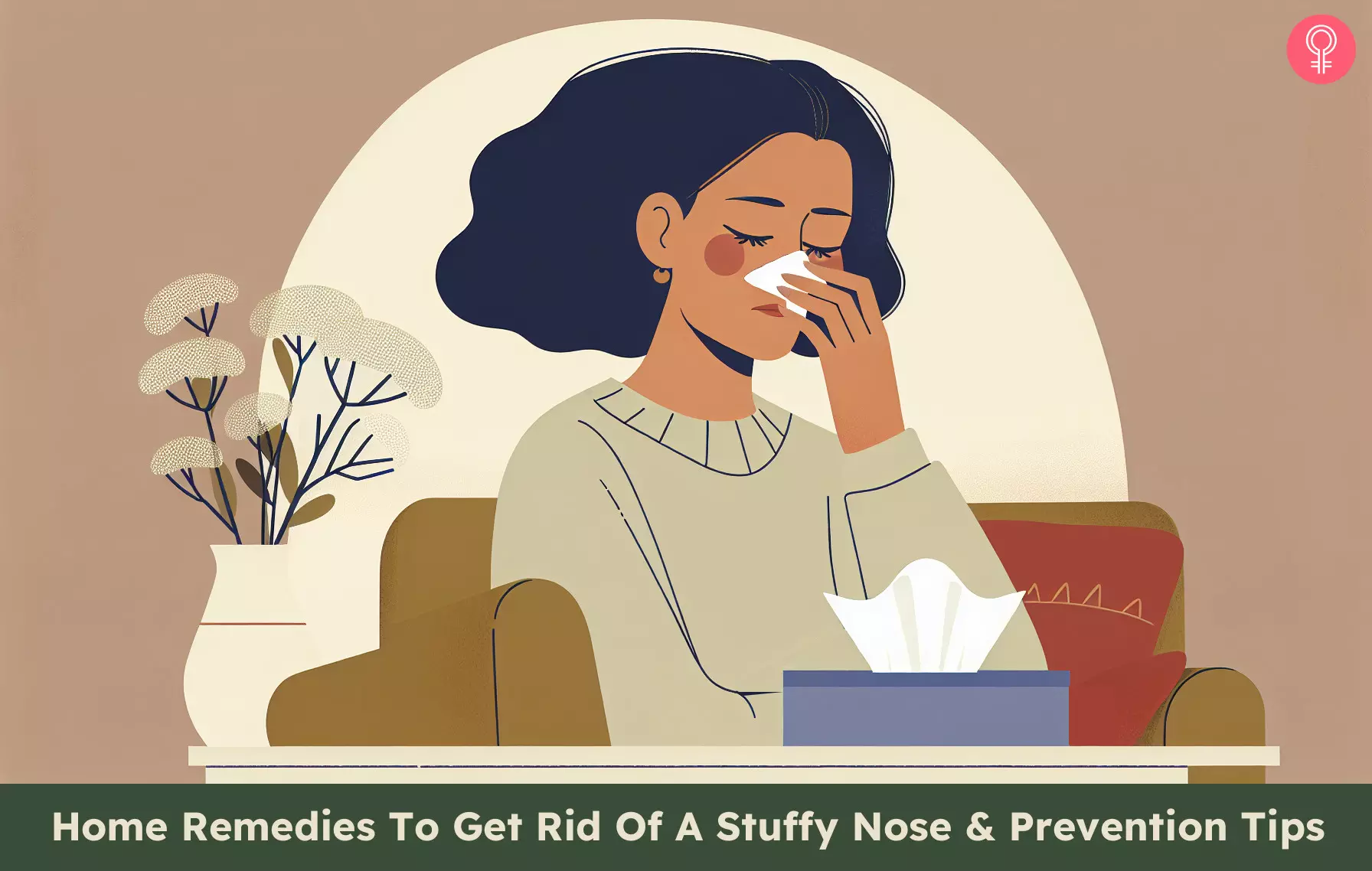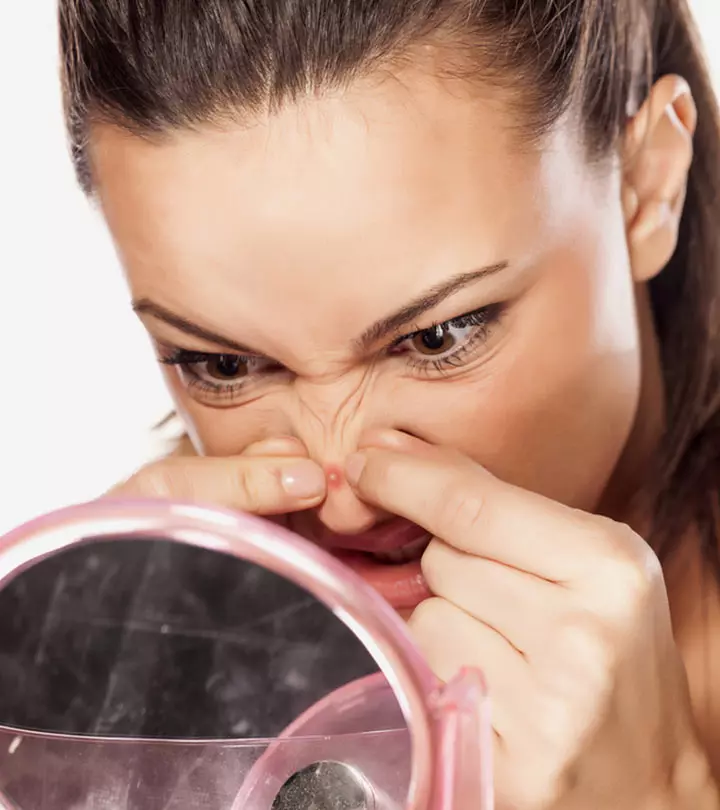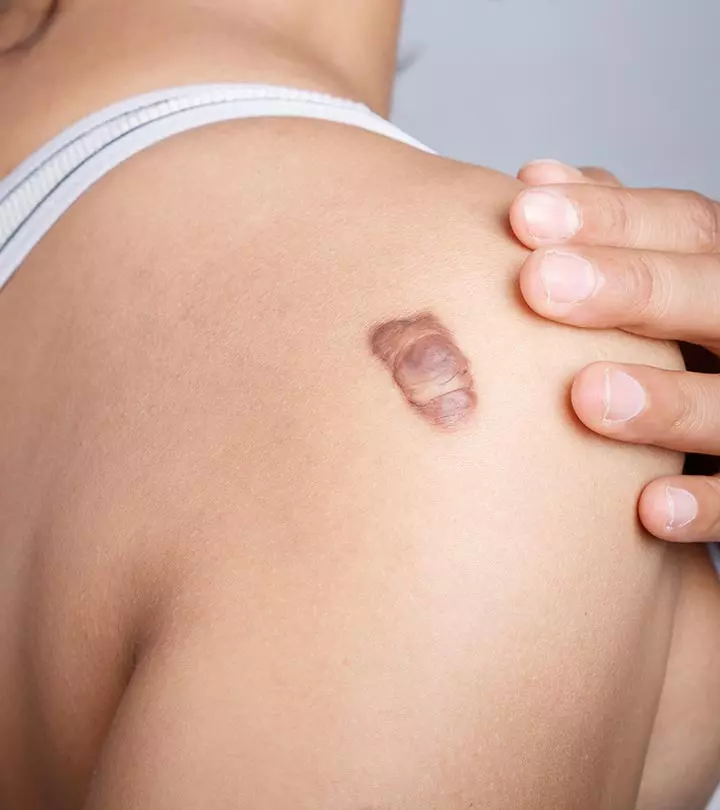13 Home Remedies To Get Rid Of A Stuffy Nose & Prevention Tips
A congested nose raining on your parade? Here's how you can fix it easily!

Image: Shutterstock
It’s flu season and sitting on your bed with a stuffy nose, no appetite, and fever can be a real downer. Trying to breathe through your congested nose can be a task in itself and can surely spoil your day-to-day activities. Fret not, there are a couple of remedies you can give a go to get rid of your stuffy nose. In this article, we delve deeper into the signs and causes of a stuffy nose and provide effective home remedies, hydration tips, and prevention methods to get rid of it.
In This Article
What Is A Stuffy Nose?
Stuffy nose is a commonly used term for nasal congestion. Most often, this condition is a result of an underlying health issue – like the common cold.
A stuffy nose is often associated with the following signs and symptoms.
Key Takeaways
- Use nasal saline sprays to hydrate the nasal passages and flush out any irritants causing congestion.
- Using a saline solution in a neti pot can clean the nasal passages by removing irritants and congestion.
- Use eucalyptus and peppermint essential oils to clear the nasal passages and stuffiness.
- Drinking lots of water can help to lessen stuffiness and thin mucus.
Signs And Symptoms Of A Stuffy Nose
- A runny nose
- Pain in the sinus
- Buildup of mucus
- Swelling of the nasal tissue
Many newborns may also have nasal congestion that may last for a month.
The congestion may also be accompanied by sneezing and is completely normal. Infants may also have trouble feeding due to a stuffy nose.Nasal syringing is commonly used for infants, why not for adults!
One of the main reasons for a stuffy nose is inflammation of your nostrils. The causes of a stuffy nose are listed right below.
What Causes A Stuffy Nose?
A stuffy nose can occur due to minor illnesses like:
- Cold
- Flu
- Sinusitis
 Trivia
TriviaThe symptoms due to such illnesses usually improve within a week. However, if you have been experiencing nasal congestion for a long time, or it hangs on after a cold, it could be because of the following conditions:
- Allergies (dairy, gluten, sugar)
- Hay fever (pollen, grasses, dust)
- Nasal polyps (benign or non-cancerous growths in the nasal passage)
- Exposure to chemicals
- Environmental irritants
- Chronic sinusitis
- Deviation of the nasal septum
- Yeast overgrowth
If you have experienced nasal congestion, you know how difficult and bothersome it can be. It can cause you to lose your appetite and make breathing quite difficult.
In a study conducted on 8,000 adults, it was found that 49.1% of them suffered from nasal congestion. It was found that 42.9% of participants who had nasal congestion had physician diagnosed allergic rhinitis. It was also observed that participants who smoked or were exposed to tobacco smoke or other occupation irritants had more chances of getting stuffy nose. So follow the home remedies to manage the symptoms of nasal congestion.
To help you clear your stuffy nose and restore your normal breathing, we have compiled a set of natural remedies. Try them out!
Home Remedies To Get Rid Of A Stuffy Nose
1. Warm Compress

You Will Need
- A clean washcloth
- Hot water
What You Have To Do
- Take a bowl of water and heat it.
- Soak a clean washcloth in the bowl and place it over your nose and forehead.
- Leave it on for a minute or two and remove.
- Repeat 3 to 4 times.
How Often You Should Do This
Do this 2 to 3 times daily until you notice an improvement in your condition.
Why This Works
The heat from the warm compress helps in reducing the swelling and inflammation in your inflamed nasal passages and sinus cavities.
This decongests your nose and makes breathing a lot easier (1).
2. Apple Cider Vinegar
You Will Need
- 1 teaspoon of apple cider vinegar
- 1 glass of warm water
What You Have To Do
- Add a teaspoon of apple cider vinegar to a glass of warm water.
- Mix well and drink the solution.
How Often You Should Do This
You must drink this 1 to 2 times daily.
Why This Works
Apple cider vinegar contains acetic acid and potassium, both of which can help relieve symptoms of a stuffy nose.
Potassium helps in thinning the mucus, and acetic acid fights microbial infections causing the congestion (2). ACV is also one of the most popular home remedies to stop postnasal drip, as it soothes the nasal passage.
3. Peppermint Tea

You Will Need
- 8-10 peppermint leaves
- 1 cup of water
What You Have To Do
- Add the peppermint leaves to a cup of water.
- Bring it to a boil in a saucepan.
- Simmer for 5 to 10 minutes and strain.
- Drink it up.
How Often You Should Do This
You can drink peppermint tea 1 to 2 times daily.
Why This Works
Peppermint contains menthol that acts as a decongestant due to its anti-inflammatory properties and helps in relieving symptoms of a stuffy nose
4. Essential Oils
a. Eucalyptus Oil
You Will Need
- 6 drops of eucalyptus oil
- 1 bowl of hot water
- A towel
What You Have To Do
- Add six drops of eucalyptus oil to a bowl filled with hot water.
- Bend your head over the bowl and inhale the steam.
- Cover your head with a towel to prevent the steam from escaping.
How Often You Should Do This
You must do this once daily.
Why This Works
One of the major constituents of eucalyptus oil is eucalyptol. Eucalyptol exhibits anti-inflammatory activities that help in reducing the inflammation and swelling in your nasal passage, and clears the airways, thereby relieving nasal congestion (5). The anti-inflammatory activities of eucalyptus oil also make it one of the most popular home remedies for chest congestion.
b. Thyme Oil
You Will Need
- 6-7 drops of thyme oil
- A bowl of hot water
- A towel or blanket
What You Have To Do
- Add six to seven drops of thyme oil to a bowl of hot water.
- Bend over the bowl and cover your head with a towel.
- Inhale the steam.
How Often You Should Do This
You must follow this procedure as and when required.
Why This Works
Thyme oil contains thymol, a powerful antimicrobial agent that can help fight infections (6). It is also anti-inflammatory and helps with nasal inflammation (7).
c. Rosemary Oil
You Will Need
- 6-7 drops of rosemary oil
- A bowl of hot water
- A towel or blanket
What You Have To Do
- Add a few drops of rosemary oil to a bowl or vaporizer filled with hot water.
- Inhale the aromatic steam.
- Cover your head with a blanket or towel to prevent the vapors from escaping.
How Often You Should Do This
Do this once daily until your symptoms subside.
Why This Works
Rosemary contains constituents like camphor and cineole (eucalyptol) (8). These compounds help in relieving symptoms of cough and cold due to their anti-inflammatory activities (9). This aroma therapy works wonders for a stuffy nose.
5. Neti Pot

You Will Need
- A neti pot
- Distilled saline water
What You Have To Do
- Take a neti pot and fill it with distilled saline water.
- Tilt your head over a sink and pour the saline solution from the neti pot into one of your nostrils.
- Allow the water to drain through your lower nostril.
- Repeat with the other nostril.
- Breathe through your mouth while following this procedure.
- Rinse your neti pot with distilled water and air dry it after every use.
How Often You Should Do This
Do this 3 to 4 times daily until you notice an improvement in your symptoms.
Why This Works
Saline nasal irrigation using a neti pot helps in thinning the mucus and flushing out the nasal passages
(10).
Note: You may put one drop of tea tree oil in the neti pot to fight viral, bacterial, or fungal infection.
 Did You Know?
Did You Know?6. Salt And Water
You Will Need
- 1 cup of warm distilled water
- ½ teaspoon of salt
What You Have To Do
- Add half a teaspoon of salt to a cup of warm distilled water.
- Mix well until the salt dissolves completely.
- Bend over a basin and sniff the water, one nostril at a time.
- Repeat with the other nostril.
- This method is best for those who do not have a neti pot.
How Often You Should Do This
Follow this remedy as and when required.
Why This Works
Nasal irrigation with saline water has shown to be effective in clearing stuffy noses. It can also help with nasal congestion associated with allergies, cold, and sinusitis (11). Whether you are looking for home remedies for sinus infections or common cold, saltwater is an effective solution.
7. Coconut Oil

You Will Need
1 teaspoon of cold pressed coconut oil
What You Have To Do
- Take a teaspoon of cold pressed coconut oil and warm it.
- Rub the warm coconut oil on either side of your nose.
- Leave it on until your skin absorbs it completely.
How Often You Should Do This
You must do this 2 to 3 times daily.
Why This Works
The topical application of coconut oil on your nose has decongesting effects. These effects could be due to the strong moisturizing, antipyretic, and anti-inflammatory activities of coconut oil (12).
8. Garlic
You Will Need
- 3-5 crushed garlic cloves
- A bowl of water
- A towel
What You Have To Do
- Bring a bowl of water to a boil in a saucepan.
- Simmer for 5 minutes and remove from the stove.
- Lean over the bowl of water and inhale the steam.
- Cover your head with a clean towel or blanket while doing so.
- You can also add garlic to your daily diet.
How Often You Should Do This
You must do this at least twice daily for faster relief.
Why This Works
Garlic is a popular remedy used for clearing cough and congestion as it has expectorant and antimicrobial properties (13). Garlic also has anti-inflammatory properties that help in relieving swelling and inflammation in the nostrils (14).
9. Ginger

You Will Need
- 2-3 inches of sliced garlic
- A bowl of water
- A clean washcloth
What You Have To Do
- Add 2 to 3 inches of garlic to a bowl of water.
- Bring it to a boil in a saucepan.
- Simmer for 5 minutes and remove from the stove.
- Allow the ginger solution to cool a little.
- Once the solution is warm enough to be applied on the skin, soak a washcloth in it and wring out the excess water.
- Place it over your face and
- leave it on for a minute or two.
- Repeat the process at least thrice.
- You can also drink a hot cup of ginger tea for added benefits.
Volker, a blogger recalls his personal experience of using ginger for treating stuffy nose and flu, relieving cold symptoms, and other related ailments. He connotes an ayurvedic angle to these disorders and adds, “The body builds up an excess of mucus, resulting in familiar symptoms such as runny nose, cough, and congestion (i).” For remedy, he shares that he likes to prepare a ginger-cinnamon-lemongrass tea and explains the entire process as well.
How Often You Should Do This
Do this twice daily until you notice an improvement in your condition.
Why This Works
Ginger has anti-inflammatory and antimicrobial properties, which make it your best bet for treating nasal congestion (15). Ginger helps in reducing nasal swelling and fighting the flu-causing microbes. It is also an effective solution if you want to know how to stop a runny nose.
10. Pressure Points
Applying gentle pressure or massaging certain pressure points near your nose, like the bridge of your nose, both the sides of the nose right under your temple, the edge of your nostrils, or even the base of your skull, can help in treating as well as preventing nasal congestion.
11. Saline Spray
You Will Need
- 8 ounces of water
- ½ teaspoon of salt
- A dropper bottle
What You Have To Do
- Boil 8 ounces of water.
- Remove from the stove and allow it to cool for some time.
- Add half a teaspoon of salt to the lukewarm water.
- Once the solution cools down completely, transfer it to a spray or dropper bottle.
- Spray into one of your nostrils and allow the water to drip out of the other nostril.
- Repeat for the second nostril.
How Often You Should Do This
Follow this procedure 2 to 3 times daily for faster recovery.
Why This Works
Using a saline spray is exactly like using a neti pot. It helps in nasal irrigation, flushing out excess mucus and relieving nasal congestion (16).
All these remedies will definitely give you relief from nasal congestion and also prevent its recurrence to a large extent. You should also follow a few prevention tips to help these remedies work even better.
12. Drink Plenty Of Water
Your nasal passages may be clogged because your mucus is too thick. Simple hydration can help thin your mucus.
Water Guidelines: Drink half your body weight (in pounds) in ounces of water. If you weigh 150 lbs, you will drink 75 ounces. Add ¼ tsp of sea salt or Himalayan salt to every quart of drinking water.
13. Avoid Mucus-Building Foods Like Sugar, Gluten, And Dairy
Do an experiment of one week to 10 days avoiding these foods and see how you feel. After the trial, eat one food at a time in large quantities and see if your nasal congestion returns.
14. Consume Foods like Turmeric, Cayenne Pepper, And Carom Seeds
Turmeric has anti-inflammatory properties. It helps in reducing inflammation inside the sinuses and nasal tract and helps drain nasal secretions. The capsaicin found in cayenne pepper can help in drying up the mucus in the nasal passages, making it easier to breathe by reducing nasal stuffiness. Carom seeds can also help in reducing nasal stuffiness. All you need to do is place a handful of carom seeds on a cotton cloth and tie it into a bundle. Warm this pack on a heated pan and place it on the head and nasal areas for a few minutes.
Research suggests that yoga may also help reduce nasal congestion (17). Check out some yoga asanas you can try.
Yoga For Stuffy Nose
1. Bridge Pose – Beginners

- Lie on your back on a yoga mat, with your hands on either side of your hips.
- Lift both knees, keeping your feet and back firmly on the mat.
- Inhale and lift your hips till they form a diagonal line with your shoulders and feet.
- Hold the pose for 30 seconds.
- Exhale slowly and return to the starting position.
2. Plow Pose – Advanced

- Lie on your back with your hands under your hips and fingers interlocked.
- Inhale and lift both your legs slowly over your head.
- Touch your toes to the ground above your head and hold the pose for 15-30 seconds.
- Slowly bend your hips and lift your legs to return to the starting position.
- You can pair the following prevention tips with these home remedies and yoga poses to treat a stuffy nose.
Once you’ve tackled your nasal congestion, it’s important that you learn prevention tips you can follow to avoid reoccurrence. Keep reading.
Prevention Tips
- Use a humidifier in your room to keep the air around you moist and decongest your stuffy nose.
- Take a warm shower.
- Drink lots of fluids and keep yourself well hydrated.
- Keep your head elevated as it makes breathing easier.
- Avoid using chlorinated water as it may further irritate your nasal passages.
- Practice exercises and yoga poses that involve deep breathing.
- Use non-iodized salt or sea salt in your neti pot or for nasal flushing.
Now you know how to get rid of a stuffy nose the next time you experience it. Any of the above remedies will give you almost immediate relief from the symptoms of nasal congestion. But, if your condition keeps deteriorating, it is best to seek medical attention, especially if your nasal mucus is green in color indicating a bacterial infection. Affected toddlers must also get medical attention as early as possible to prevent problems in feeding and breathing.
Learn how to clear a stuffy nose instantly. Watch this video that offers some simple steps to get rid of congestion and associated discomfort.
Infographic: 5 Natural Ways To Treat A Stuffy Nose
A congested nose can be annoying. You keep sniffling, can’t smell anything, and your head feels heavy. Plus, the fever and the breathing difficulty can disrupt your daily activities. The good news is you may find some relief and manage your stuffy nose with some simple remedies at home. Check out this infographic to learn more.
Some thing wrong with infographic shortcode. please verify shortcode syntaxMinor illnesses like flu, cold, and sinusitis often include a stuffy nose as one of their symptoms. This nasal congestion usually eases away within a week. It may, however, last longer in some cases. The above-mentioned home remedies, like warm compress, apple cider vinegar, peppermint tea, essential oils, ginger, and garlic, can help you get rid of a stuffy nose by reducing the inflammation and swelling in the nostrils and thinning out the mucus before flushing it out. So, make sure you give them a shot. If your condition is worsening and you are getting a green mucus discharge, consult a doctor and get treated for a possible bacterial infection.
Frequently Asked Questions
When should I see a doctor for nasal congestion?
It is better to see a doctor for nasal congestion if:
• your congestion lasts longer than 10 days
• you have fever for three or more days
• there is a green discharge from your nose, accompanied by sinus pain
• you have been experiencing asthma attacks
How long does nasal congestion last?
Nasal congestion usually clears in about a week if it is due to some minor infection. However, if it lasts longer, consult a doctor immediately.
Is it normal for one nostril to be blocked?
Half of your nose could be blocked due to many reasons. Inflammation due to allergies can cause one of your nasal passages to be more swollen than the other. A deviated nasal septum is another cause for this development. Most of the times, it is completely normal for one of your nostrils to be blocked. In fact, your body also orders your nostrils to work one after the other.
How should you sleep with a stuffy nose?
If you have a stuffy nose, you need to sleep by popping a couple of pillows below your head. This helps in keeping your head elevated throughout the night, making breathing much easier.
What is the best medicine for a stuffy nose?
Medical treatment for a stuffy nose may include taking medications like oral antihistamines, antibiotics, or decongestants. You can also use nasal sprays and nasal steroids. However, be aware that you can get “addicted” to nasal steroid sprays. If you are looking for natural alternatives to relieve the condition, any of the above home remedies will do the trick.
Does blowing your nose make congestion worse?
Possibly. According to anecdotal evidence, blowing a stuffy nose may lead to a pressure build-up that causes the mucus to clog your sinuses.
Why is a blocked nose worse at night?
Your sleeping position, the shift in the blood flow, or extended exposure to potential allergens during sleep may make it difficult for your sinuses to drain naturally.
Does applying Vicks on feet work for a stuffy nose?
Possibly not. There is a lack of evidence supporting this claim. However, applying it around the nose area and to your chest may help.
Illustration: Home Remedies To Get Rid Of A Stuffy Nose & Prevention Tips

Image: Dall·E/StyleCraze Design Team
Personal Experience: Source
StyleCraze's articles are interwoven with authentic personal narratives that provide depth and resonance to our content. Below are the sources of the personal accounts referenced in this article.
(i) Ayurvedic Remedies and Yoga Practices for Colds and Fluehttps://volkermann.wordpress.com/2014/09/11/ayurvedic-remedies-and-yoga-practices-for-colds-and-flue/
Read full bio of Dr. Bhakti Kapse
Read full bio of Shaheen Naser
Read full bio of Arshiya Syeda
Read full bio of Dipti Sharma


























Community Experiences
Join the conversation and become a part of our empowering community! Share your stories, experiences, and insights to connect with other beauty, lifestyle, and health enthusiasts.